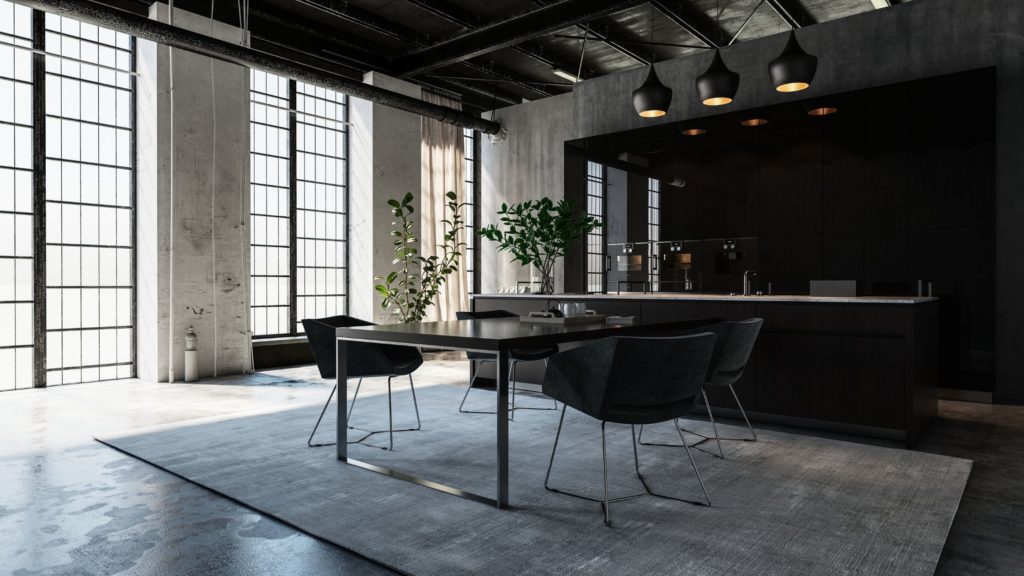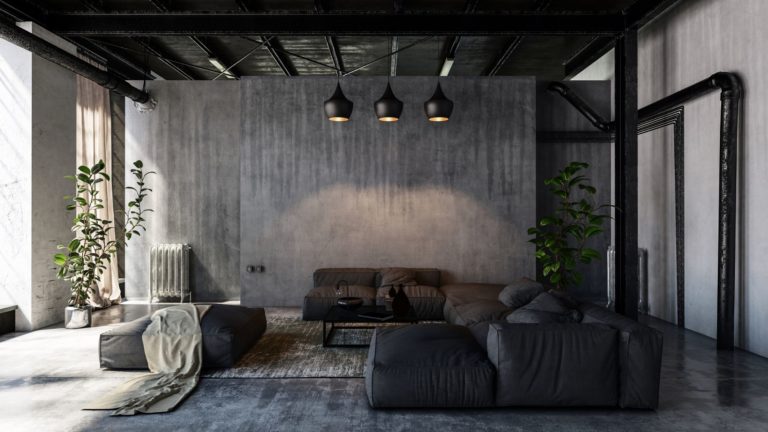In the vast realm of interior design, the industrial minimalistic approach stands out as one of the most intriguing. The style is a captivating blend of rawness, simplicity, and authenticity. While both minimalism and industrial design have individual narratives, their union in interior spaces brings forth a uniquely balanced and aesthetically stimulating environment. To understand this, one must delve into the primary components: materials, color palettes, and inspirations.
1. Materials: Embracing the Raw and Unfinished
The most distinctive feature of the industrial minimalist style is its choice of materials. The emphasis is on honest, unrefined textures that communicate a raw aesthetic. Here are the keystones:
- Brick: Exposed brick walls exude an undeniably industrial vibe. They’re not just walls but rather canvases that narrate tales of times gone by. Whether left in its raw state or painted over, brick remains a minimalist favorite for its natural pattern and tactile appeal.
- Concrete: From polished concrete floors to walls and countertops, this material embodies the industrial spirit. Its cold, austere, and neutral persona works perfectly in minimalist settings, providing a canvas that highlights other elements without overshadowing them.
- Metal: Whether it’s in the form of exposed beams, ductwork, or furniture frames, metal adds a rugged touch. Steel, iron, and aluminum are commonly used, often with visible welds and rivets, enhancing the rawness.
- Wood: Contrasting the coldness of metal and concrete, wood brings warmth. Reclaimed wood, in particular, bears marks of its previous life, aligning well with the style’s ethos.
2. Color Palettes: Neutrality and Subtlety
The industrial minimalist color palette steers clear of overly vibrant shades. Instead, it finds solace in neutral tones, drawing inspiration from the inherent colors of the materials used.
- Greys: From the lightest ash to deep charcoal, greys echo the concrete surfaces and metallic elements commonly found in industrial settings.
- Whites: An ideal backdrop for any minimalist setting, white brings in brightness and a sense of space, essential for preventing the style from feeling too heavy.
- Browns: Reflecting wooden elements and some natural brick surfaces, brown shades offer warmth. This broad spectrum can range from light beige to rich mahogany.
- Accents: While the core palette is neutral, splashes of muted colors, like olive green, deep blues, or burnt oranges, can be introduced for added depth. These shades remain grounded and never overpower the primary muted palette.

3. Inspirations: From Warehouses to Contemporary Homes
The marriage of minimalism and industrial design is heavily influenced by historical settings, especially factories, warehouses, and barns of the bygone era.
- Factories and Warehouses: Abandoned factories turned into lofts initiated the industrial style trend. With their high ceilings, exposed beams, and ductwork, they offered ample space that beckoned a minimalist approach to avoid feeling cluttered.
- Open Floor Plans: The expansive and unsegmented spaces seen in warehouses serve as inspirations. Homes styled in this manner often feature open concepts, where rooms flow seamlessly into each other without rigid divisions.
- Vintage Accents: Industrial minimalism doesn’t shun decor. Instead, it embraces vintage or industrial-themed pieces that tell a story. Old factory tools, vintage lamps, or signage can be incorporated to add character.
- Modern Innovations: While rooted in history, the style doesn’t ignore modernity. Innovative lighting solutions, sleek modular furniture, and advanced home appliances are harmoniously integrated, paying homage to both the old and the new.
4. Functionality: Design Meets Practicality
One cannot discuss minimalism without mentioning functionality. Marrying it with the industrial style accentuates this functional aspect, creating spaces that are not just visually appealing but also supremely useful.
- Purposeful Furnishings: In an industrial minimalist space, every piece of furniture is purposeful. There’s no room for frivolities. Think of sleek metal-framed chairs, wooden tables with raw, unpolished finishes, or couches in muted colors that offer comfort without unnecessary adornments.
- Space Utilization: The industrial style’s roots in factories and warehouses mean that it understands the value of space. High ceilings often feature hanging storage options, while open floor plans ensure that every square foot is put to good use.
- Uncluttered Surfaces: Minimalism despises clutter. In these interiors, countertops, tables, and other surfaces remain largely free, with maybe a vintage lamp or plant for decor. This also emphasizes the raw materials of the space, allowing them to shine.
- Efficient Lighting: One can find a blend of functional and aesthetic lighting solutions. Large windows, often unadorned or with simple blinds, invite natural light. For artificial sources, pendant lights, especially those with metal finishes, or exposed bulbs, capture the essence perfectly.
5. Evolution: The Future of Industrial Minimalism
As with all design languages, industrial minimalism too is bound to evolve. While its foundational principles will remain, there are emerging trends and shifts that signify its future direction.
- Sustainable Materials: The emphasis on sustainability has led designers to seek eco-friendly materials that still resonate with the raw, unfinished industrial vibe. Reclaimed wood, recycled metal, and other repurposed materials are making their way into these spaces.
- Biophilic Elements: While industrial minimalism has always flirted with nature through its use of woods and natural finishes, a more direct incorporation is on the horizon. Indoor plants, vertical gardens, and water features are being integrated, offering a refreshing contrast to the cold, hard surfaces.
- Technology Integration: Smart homes are the future. Industrial minimalism is embracing this by incorporating technology in a way that’s seamless. Hidden panels, touch-sensitive surfaces, or voice-controlled lights are some ways in which tech is melding into this design aesthetic.
- Global Influences: As the world becomes more connected, design languages intermingle. Touches of Scandinavian simplicity, Japanese Zen, or Mediterranean warmth can be found infiltrating the industrial minimalist spaces, offering a rich tapestry of design that’s both global and unique.
Wrapping Up
With these added layers, industrial minimalism proves to be a fluid, adaptable, and forward-looking design language. It’s more than just a fusion of two styles; it’s a reflection of our evolving lifestyles and priorities. By understanding its roots, principles, and potential directions, one can create spaces that are not just aesthetically appealing but also deeply resonant with the times.
In Conclusion
Minimalism and industrial design might seem, at first glance, an odd pair. One thrives on simplicity and the other on rugged authenticity. However, their synergy creates an aesthetic that’s both nostalgic and contemporary. The raw materials evoke histories of industrial eras, while the muted color palette and functional design principles of minimalism ensure the space remains calm, uncluttered, and timelessly chic.
For those seeking a balance between the past and the present, between raw authenticity and sleek simplicity, the industrial minimalist style is a journey worth embarking on.


